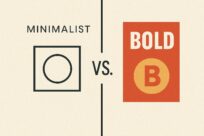
Latest Articals

Minimalist vs. Bold Branding: Which Style Fits Your Business?
Branding is always a choice. And like every choice in business, making the wrong one can cost you.
Some companies strip everything down. They go clean, simple, and minimal. Think Apple. Think Nike. Their branding relies on a logo, a single color, and a whisper of design.
Other companies take the opposite path. They go big. Loud colors. Sharp typography. In-your-face visuals. Think Red Bull. Think Supreme. These brands don’t whisper — they shout.
The truth is, both approaches work. And both approaches can fail. The real question isn’t which one is “better,” but rather: which one fits your business?
Let’s cut through the noise and unpack what each branding style really means — and how to decide which one will fuel your growth.
What Minimalist Branding Really Means
Minimalist branding is about subtraction. The idea is simple: take away everything unnecessary until only the essentials remain.
The philosophy goes like this: the less clutter, the more clarity. By removing distractions, you allow your brand’s core message to shine.
You’ll recognize minimalist branding in:
- Simple logos. One shape, one idea, no fluff.
- Neutral colors. White, black, grey, maybe one accent.
- Clean typography. Fonts that disappear into the background.
- Plenty of space. No crammed visuals, no noise.
Why does it work?
- It feels premium. Minimalist branding signals sophistication and luxury.
- It lasts longer. Trends fade, but simplicity stays timeless.
- It’s flexible. A simple mark adapts across packaging, websites, and ads without losing impact.
Take Apple’s bitten apple logo. It doesn’t need an explanation. The brand stripped away everything until the mark became iconic.
However, minimalist branding does carry risk. If you go too simple, you risk looking bland. And if your brand lacks personality or story, minimalism can make you disappear entirely.
What Bold Branding Really Means
Bold branding sits on the other end of the spectrum. Instead of taking away, it’s about adding impact. Colors that punch. Fonts that command attention. Graphics that demand a second look.
You’ll see bold branding in:
- Vibrant palettes. Neon greens, fire reds, deep purples.
- Heavy typography. Fonts that dominate the page and stick in memory.
- Dynamic imagery. Motion, energy, and attitude baked into visuals.
- Playful elements. Shapes, patterns, and textures that demand notice.
Why does it work?
- It gets noticed. Bold branding is impossible to scroll past or ignore on a shelf.
- It creates emotion. Excitement, energy, passion — all visualized through design.
- It builds a tribe. Loud branding attracts loyal fans who rally behind the message.
Look at Red Bull. Their visuals are aggressive and adrenaline-packed. They don’t just sell energy drinks; they sell a lifestyle of extremes. You know instantly who they’re talking to: young, fearless, thrill-seekers.
But bold branding has its dangers. Push too far, and your brand starts looking cheap or chaotic. Too many colors, too much text, and suddenly you’re not commanding attention — you’re overwhelming people.
Minimalist vs. Bold: The Core Differences
At the heart of it, the choice comes down to a single contrast:
- Minimalism whispers quality. It says, “We don’t need to scream. Our product speaks for itself.”
- Boldness shouts identity. It says, “This is who we are. Join us or step aside.”
Minimalist brands are confident. Bold brands are charismatic. One invites you quietly, the other pulls you in with energy.
Neither approach is inherently right or wrong. But only one will be right for your business.
Choosing the Right Style for Your Business
So how do you know which direction to take? Here’s a framework.
1. Who Is Your Audience?
Your audience decides your design. Period.
- Selling luxury goods? Minimalism signals class and trust.
- Selling streetwear? Bold design builds community and hype.
- Serving executives? Clean and restrained branding works better.
- Serving teens? Bright, bold, and playful gets attention.
Match the energy of your market. Speak their visual language, not yours.
2. What Is Your Offer?
Your product or service plays a major role.
- High-ticket items benefit from minimalist branding — it builds credibility.
- Fast-moving, impulse-driven products thrive on bold branding — it drives excitement.
A luxury watch company doesn’t need neon green to prove its worth. A new energy drink, on the other hand, almost certainly does.
3. Where Will Your Branding Live?
Consider the channels where your branding will appear most.
- On Instagram, bold colors cut through crowded feeds.
- On packaging, minimalism often feels more premium.
- On billboards, bold grabs attention fast.
- On websites, minimal builds trust and authority.
Your main marketing channel should influence your style.
4. What’s Your Long-Term Vision?
Minimalism is timeless. Bold branding rides trends.
Ask yourself: do you want to look classic for decades, or do you want to dominate right now? Both approaches can be profitable, but they pull in different directions.
Real-World Examples
Let’s compare side by side:
- Apple (Minimalist). White space. One logo. One product front and center. The message? “We’re premium. We don’t compete. We define the category.”
- Red Bull (Bold). Explosions of color. Athletes mid-air. The message? “We’re for thrill-seekers. If you don’t get it, you’re not our customer.”
- Chanel (Minimalist). Black and white. Classic serif typography. The message? “Timeless elegance.”
- Supreme (Bold). Red box logo. Oversized typography. The message? “Culture. Exclusivity. Rebellion.”
Both styles work. Both create loyalty. Both drive sales. The key is alignment: the style must fit the story.
Mistakes to Avoid
Plenty of businesses misstep when it comes to branding. Here are the biggest traps:
- Mixing both styles. Minimalism and boldness rarely blend well. Pick one lane.
- Chasing trends blindly. Neon might be hot this year, but will it resonate with your audience five years from now?
- Designing for yourself, not your audience. You might love clean minimalism, but if your buyers crave energy, you need to deliver boldness.
- Forgetting clarity. A pretty style means nothing if customers don’t understand your brand within seconds.
At its core, branding is about communication, not decoration. Never confuse the two.
The Payoff of Choosing Right
When your branding matches your business, everything gets easier.
- Customers understand you instantly.
- Your message cuts through the noise.
- Marketing becomes consistent and cohesive.
- Sales conversations shorten — because people already know what you stand for.
The wrong style does the opposite. It confuses buyers, weakens your message, and makes you look like everyone else.
The right style makes you memorable. And in business, memorability equals money.
So… Minimalist or Bold?
Here’s the bottom line:
- If you want timeless trust and a premium feel, go minimalist.
- If you want fast attention and a magnetic tribe, go bold.
But don’t choose based on personal taste. Choose based on your audience, your offer, your main channel, and your long-term vision. Branding isn’t an art project. It’s a business decision.
Minimalist branding whispers. Bold branding shouts. Both can win — but only when they fit.
The Decision
So now the question is yours: are you the brand that wins through quiet authority, or the brand that dominates through bold personality?
At The Clay Media, we help businesses stop guessing and start branding with intent. We design brands that fit — perfectly. Brands that speak the language of your audience and capture attention in exactly the right way.
If you’re ready to choose the branding style that will define your business, the next step is simple.
Contact us today. Let’s build the brand identity your business deserves.
Recent Blogs

Ongoing Website Maintenance Agency for Service Businesses — Why It Matters
Running a service-based business online requires constant reliability. Therefore, your website must stay secure, fast, and fully functional. As a …

Business Website Update and Backup Services — Why They’re Essential in 2025
Business Website Update and Backup Services — Why They’re Essential in 2025 Running a business online isn’t just about having …

Website SEO | Seed Maintenance Services
Why SEO is Crucial for Seed Services Search Engine Optimization (SEO) is the foundation of online visibility. For seed maintenance …

